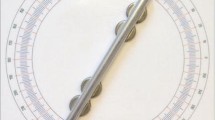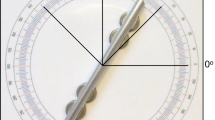Abstract
What humans haptically perceive as parallel is often far from physically parallel. These deviations from parallelity are highly significant and very systematic. There exists accumulating evidence, both psychophysical and neurophysiological, that what is haptically parallel is decided in a frame of reference intermediate to an allocentric and an egocentric one. The central question here concerns the nature of the egocentric frame of reference. In the literature, various kinds of egocentric reference frames are mentioned for haptic spatial tasks, such as hand-centered, arm-centered, and body-centered frames of reference. Thus far, it has not been possible to distinguish between body-centered, arm-centered, and hand-centered reference frames in our experiments, as hand and arm orientation always covaried with distance from the body-midline. In the current set of experiments the influence of body-centered and hand-centered reference frames could be dissociated. Subjects were asked to make a test bar haptically parallel to a reference bar in five different conditions, in which their hands were oriented straight ahead, rotated to the left, rotated to the right, rotated outward or rotated inward. If the reference frame is body-centered, the deviations should be independent of condition. If, on the other hand, the reference frame is hand-centered, the deviations should vary with condition. The results show that deviation size varies strongly with condition, exactly in the way predicted by the influence of a hand-centered egocentric frame of reference. Interestingly, this implies that subjects do not sufficiently take into account the orientation of their hands.







Similar content being viewed by others
References
Appelle S, Countryman M (1986) Eliminating the haptic oblique effect: influence of scanning incongruity and prior knowledge of the standards. Perception 15:325–329
Appelle S, Gravetter F (1985) Effect of modality-specific experience on visual and haptic judgment of orientation. Perception 14:763–773
Carrozzo M, Lacquaniti F (1994) A hybrid frame of reference for visuo-manual coordination. Neuroreport 5:453–456
Coren S (1993) The left-hander syndrome. Vintage Books, NY
Flanders M, Soechting JF (1995) Frames of reference for hand orientation. J Cogn Neurosci 7:182–195
Gentaz E, Hatwell Y (1995) The haptic oblique effect in children’s and adults’ perception of orientation. Perception 24:631–646
Heller MA, Calcaterra JA, Burson LL, Green SL (1997) The tactual horizontal-vertical illusion depends on radial motion of the entire arm. Percept Psychophys 59:1297–1311
Hermens F, Kappers AML, Gielen SCAM (in press) The structure of fronto-parallel haptic space is task dependent, Percept Psychophys
Kappers AML (1999) Large systematic deviations in the haptic perception of parallelity. Perception 28:1001–1012
Kappers AML (2002) Haptic perception of parallelity in the midsagittal plane. Acta Psychologica 109:25–40
Kappers AML (2003) Large systematic deviations in a bimanual parallelity task: further analysis of contributing factors. Acta Psychologica 114:131–145
Kappers AML (2004) The contributions of egocentric and allocentric reference frames in haptic spatial tasks. Acta Psychologica 117:333–340
Kappers AML (2005) Intermediate frames of reference in haptically perceived parallelity. In: Bicchi A, Bergamasco A (eds) Proceedings world haptics conference, IEEE computer society, Los Alamitos, pp 3–11
Kappers AML, Koenderink JJ (1999) Haptic perception of spatial relations. Perception 28:781–795
Lechelt EC, Eliuk J, Tanne G (1976) Perceptual orientational asymmetries: a comparison of visual and haptic space. Percept Psychophys 20:463–469
Millar S, Al-Attar Z (2002) The Müller-Lyer illusion in touch and vision: implications for multisensory processes. Percept Psychophys 64:353–365
Millar S, Al-Attar Z (2004) External and body-centered frames of reference in spatial memory: evidence from touch. Percept Psychophys 66:51–59
Newport R, Rabb R, Jackson SR (2002) Noninformative vision improves haptic spatial perception. Curr Biol 12:1661–1664
Paillard J (1991) Motor and representational framing of space. In: Paillard J (ed) Brain and Space. Oxford University Press, Oxford, pp 163–182
Rossetti Y, Gaunet F, Thinus-Blanc C (1996) Early visual experience affects memorization and spatial representation of proprioceptive targets. Neuroreport 7:1219–1223
Rossetti Y, Rode G, Boisson D (1995) Implicit processing of somaesthetic information: a dissociation between where and how? Neuroreport 6:506–510
Soechting JF, Flanders M (1992) Moving in three-dimensional space: frames of reference, vectors, and coordinate systems. Annu Rev Neurosci 15:167–191
Zuidhoek S, Kappers AML, Van der Lubbe RHJ, Postma A (2003) Delay improves performance on a haptic spatial matching task. Exp Brain Res 149:320–330
Zuidhoek S, Visser A, Bredero ME, Postma A (2004) Multisensory integration mechanisms in haptic space perception. Exp Brain Res 157:265–268
Acknowledgments
This research was supported by the Netherlands Organisation for Scientific Research (NWO).
Author information
Authors and Affiliations
Corresponding author
Rights and permissions
About this article
Cite this article
Kappers, A.M., Viergever, R.F. Hand orientation is insufficiently compensated for in haptic spatial perception. Exp Brain Res 173, 407–414 (2006). https://doi.org/10.1007/s00221-006-0377-y
Received:
Accepted:
Published:
Issue Date:
DOI: https://doi.org/10.1007/s00221-006-0377-y




